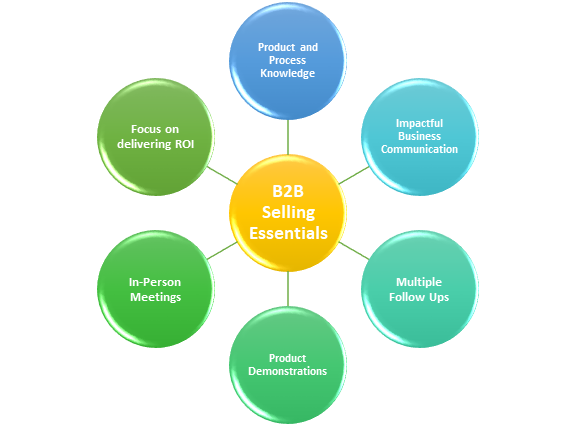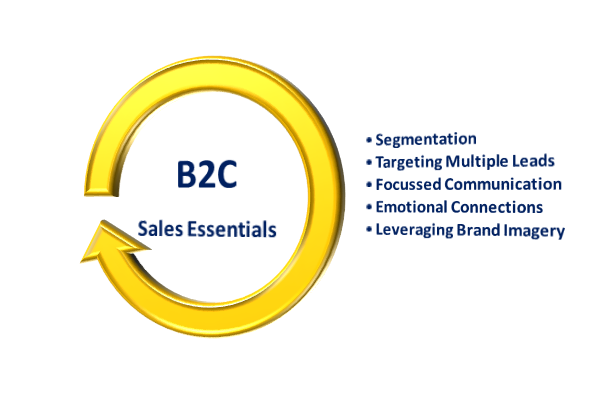The sales function needs consistent upgradation. The turbulent business environment of the 21st century waits for none and comes up with a challenge every now and then. In the time you get to understand an adverse situation, there’s a high probability your competitors will rise up to the occasion, manufacturing an edge for themselves. The way forward is remaining ahead of time with your anticipations and preparing for the worst, well in advance with the help of unique and customised sales training for your sales personnel.
There are of course different types of sales. A question might arise in your thoughts- Is sales training different for distinct types of sales or it is generalised for all of them. Let’s first understand the nuances of two major kinds of sales and then look at both of them from the perspective of training.
Table of Contents
B2B Versus B2C Sales
B2B or Business to Business and B2C or Business to Consumer are the two most prominent types of sales. While the former is selling to another business organisation, the latter involves selling to direct individual consumers. In fact, there are a host of distinctions between these two that need to be discussed in detail to move forward.
B2B
- The customer under a B2B set up is an enterprise. This enterprise consists of several decision makers. There are a lot of stakeholders involved in B2B selling.
- The sales process is complex and it may take a lot of time. The value of the product is typically high under B2B sales.
- A common example of B2B sales include a wholesaler selling to a retailer- both are business organisations. Similarly, a business consisting of manufacturing automobile accessories, selling to automobile manufacturers is another example of a business dealing with another business and not a consumer, and hence is a part of B2B sales.
B2C
On the other hand,
- The customer under a B2C set up is an individual who purchases a product for self-consumption. The individual is the only decision maker and stakeholder involved.
- The sales process is simple. The value of the product is generally low and the time along with effort required for purchasing the product from the individual point of view is low as well.
- A common example is a clothing store selling to an individual. The individual purchases for their own usage and not for resale.
Whether it’s B2B or B2C, the importance of sales training stands elevated. However, what’s important to note is the distinctions that makes sales training for B2B different from that for B2C.
Sales Training for B2B Sales
With our focus now shifting on sales training, the training for B2B sales is more product and process-oriented.
B2B selling involves a lot of steps, the leads are difficult to convert. It involves lots and lots of follow-up in multiple forms such as E-mails, calls etc. In addition, there are numerous product demonstrations and in-person meetings. Since a lot of stakeholders are involved in the decision-making process, selling takes a lot of time, effort and persistence.
B2B sales might involve your salespersons interacting with top of the ladder executives, who are busy round the clock. They aren’t easily available and even when they are, it’s only for a short duration of time that the sellers get to pitch in their product or service. There’s no room for error. As a result, they need to be highly fluent in their product knowledge and communication. Hence, the sales training for B2B is centred around product and process knowledge along with nuances of formal business communication.
Once you’re successful in selling your B2B product or service, there’s a good reason to feel elated, however, your focus now shifts towards generating repeat business. You can’t simply allow complacency to take over, no matter you’ve achieved business worth a fair amount of money. Your ultimate goal is to build a long-term relationship and bring continuous business flow to your organisation.

As we’ve talked about the decision making involved in B2B sales- it’s rigorous and may include a lot of calculations, considerations and analysis. Everything is evaluated keeping the Return on Investment in mind. The seller needs to be aware of the techniques that should be used for enhancing the profitability of a product in the eyes of the client and this is not an easy process under B2B. This requires skills that can be developed using a lot of modern training tools such as role plays and simulations that allows salespersons to practice their pitches under a controlled environment.
It’s also important to look at the nature of the customers under a B2B set up. The people who make decisions are those who are highly experienced business professionals with impressive business acumen, who are often very difficult to convince. Without people management training, it’s difficult to sell your product to such a sophisticated target audience.
Sales Training for B2C Sales
Comparing sales training for B2B sales to that for B2C sales, we find that the sales process under a B2C set up is a simple process when compared to B2B. The product knowledge, though important, isn’t something that’s mandatory to the extent that’s required under B2B sales. The single stakeholder involved makes B2C sale a one-off transaction that is carried over emotional connection formed by the customers as a result of brand messaging that’s delivered using impactful advertising and promotion. The salespersons need to learn building their pitches in sync to the core messaging of the product or service. This isn’t a case with the B2B sellers.

The volumes under B2C sales are high, though the value is low when comparing it with B2B. As a result, the salespersons are expected to target multiple leads in a short span of time. In addition, they need to target a segmented audience since their product or service would essentially serve a wide range of consumer base. They need specific training to understand the basics of identifying the most appropriate and suitable customer base with respect to their product/service. This isn’t the case under B2B since the customer base is limited to a great extent.
The audience under B2C is general. They’re the masses but that doesn’t mean they’re not segmented. Similar to B2B sales, communication is the key over here as well. However, the type of communication with masses is different to the communications with executives under a B2B sales scenario. The communication under B2C is less formal and may vary a lot on the basis of language changes across regions, especially in a diverse country like India.
The salespersons need to be trained accordingly keeping in mind the basic nature of B2C selling, which is of course distinct when compared to the B2B space.
Conclusion
Be it B2B or B2C sales training, the ultimate focus is the customer. Under the former, long-term relationships are valued, while for the latter, short emotional connections are focussed. Although some elements of B2B are being used in B2C and vice versa, the distinction remains- the approach is different, the target group is different, the product/service is different, the value involved is different, the decision-making is different and finally, the training needs are different as well.
Blurring the distinctions can help, but may not be advisable under all the conditions. With time, both B2B and B2C sales have undergone transformations. Covid19 made it necessary for the organisations to traverse the digital route. Online channels such as video calls replacing in-person meetings, VR based product demonstrations etc. have necessitated virtual sales training that not only prepares them to use the virtual platform but also teaches them nuances of online etiquettes and behaviour especially under a B2B context.
At the same time, the customers of today with respect to B2C, are more aware about the products and services, thanks to the Internet. They do their own research and comparisons. It’s difficult to manipulate and manoeuvre them towards your product or service without any solid justification.
What works under such a case are the same old selling skills powered by communication, people management, relationship and rapport building, determination, diligence and persuasion along with a set of technical skills that include product and process knowledge, digital adeptness etc. uniquely personalised with respect to the distinctions between B2B and B2C settings.
The job doesn’t finish with the completion of sales targets. Under both B2B and B2C, customer service excellence comes next and it is the key for long-term organisational success. The salespersons do have a tough job but with well-designed sales training programs and their execution, they can very well work around to become the masters of their art!


